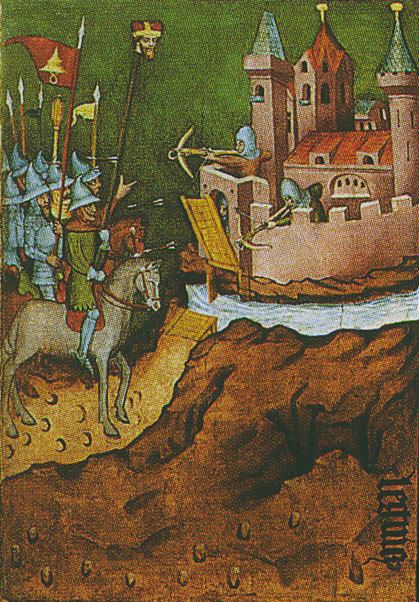 | ||
The Mongol invasion of Europe from the east took place over the course of three centuries, from the Middle Ages to the early modern period.
The terms Tatars or Tartars are applied to nomadic Mongolic peoples who, themselves, were conquered by Mongols and incorporated into their horde. They were mainly composed of Kipchaks-Cuman people.
Mongol-Tatar Golden Horde forces led by Batu Khan, (a grandson of Genghis Khan), began attacking Europe in 1223, starting with Cumans, Volga Bulgaria and Kievan Rus. They destroyed many Rus cities including Kiev, Vladimir and Moscow in the process, sparing Novgorod and Pskov however. They originally planned to continue all the way to the shores of the "Great Sea" (Atlantic Ocean). However, upon learning of the death of Ögedei Khan (third son of Genghis Khan, uncle of Batu Khan) in 1241 they returned eastwards to their steppe homelands. This arguably could have saved the rest of Europe from suffering the catastrophes that befell the armies and towns of Poland, and Hungary, however the stretched lines of communication and the lack of vast open tracts of pasture land might well have been the undoing of such a venture.
List of events
The Tatars succeeded in establishing control over Rus principalities. It included both pillaging and bloody massacres in Russian cities.
1552 Russian Moscow state 110 000 army with Kasym state 40 000 army occupated Kazan kahanate 30 000 army.
From 1599 the Polish-Lithuanian Commonwealth suffered a series of Tatar invasions, the goal of which was to loot, pillage and capture slaves into jasyr. The borderland area to the south-east was in a state of semi-permanent warfare until the 18th century. Some researchers estimate that altogether more than 3 million people, predominantly Ukrainians but also Circassians, Russians, Belarusians and Poles, were captured and enslaved during the time of the Crimean Khanate. A constant threat from Crimean Tatars supported the appearance of Cossackdom.
For years the Khanates of Kazan and Astrakhan routinely raided Russian principalities for slaves and to plunder towns. Russian chronicles record about 40 raids of Kazan Khans on the Russian territories in the first half of the 16th century. Muscovy was also being invaded by the Nogai Horde and Crimean Khanate which were successors of the Golden Horde.
In the beginning of the 16th century the wild steppe began near old Ryazan on the Oka River and Elets on the Sosna, inflow of the Don. Crimean Tatars chose to proceed along watersheds for their incursions. The main way to Moscow was "Muravski shliach", from the Crimean Perekop up to Tula between the rivers of two basins, Dnieper and Northern Donets. Having penetrated deep in the populated areas about 100-200 kilometers, the Tatars turned back and, having unwrapped wide wings, looted and captured slaves. Until the early 18th century, the khanate maintained a massive slave trade with the Ottoman Empire. Captives were sold to Turkey and the Middle East. In Crimea, about 75% of the population consisted of slaves. The Crimean city of Caffa was the main slave market.
Annually, Moscow mobilized in the spring up to 65,000 soldiers for boundary service. The defensive lines were applied, consisting of a circuit of fortresses and cities. Cossacks and young noblemen were organized into sentry and patrol services that observed Crimean Tatars and nomads of Nogai Horde on the steppe. About 30 major Tatar raids were recorded into Muscovite territories between 1558-1596.
To protect from the invasions of the Nogai Horde between the Volga and Irtysh rivers, the Volga cities of Samara in 1586, Tsaritsyn in 1589, Saratov in 1590 were founded.
The Crimean Khanate was one of the strongest powers in Eastern Europe until the 18th century. The Russian population of the borderland suffered annual Tatar invasions and tens of thousands of soldiers were required to protect the southern boundaries. This was a heavy burden for the state, and slowed its social and economic development. Since Crimean Tatars did not permit settlement of Russians to southern regions where the soil is better and the season is long enough, Muscovy had to depend on poorer regions and labour-intensive agriculture. Poland-Lithuania, Moldavia and Wallachia were also subjected to extensive slave raiding. The Crimean Khanate was conquered by the Russian Empire in 1783, bringing an end to Mongol and Tatar rule in Europe.
Historians estimate that up to half of Hungary's two million population at that time were victims of the Mongol invasion of Europe. About half of the Russian population may have died during the Mongol invasion of Rus'. Colin McEvedy (Atlas of World Population History, 1978) estimates the population of Russia-in-Europe dropped by 500,000 people, from 7.5 to 7 million in 1300.
